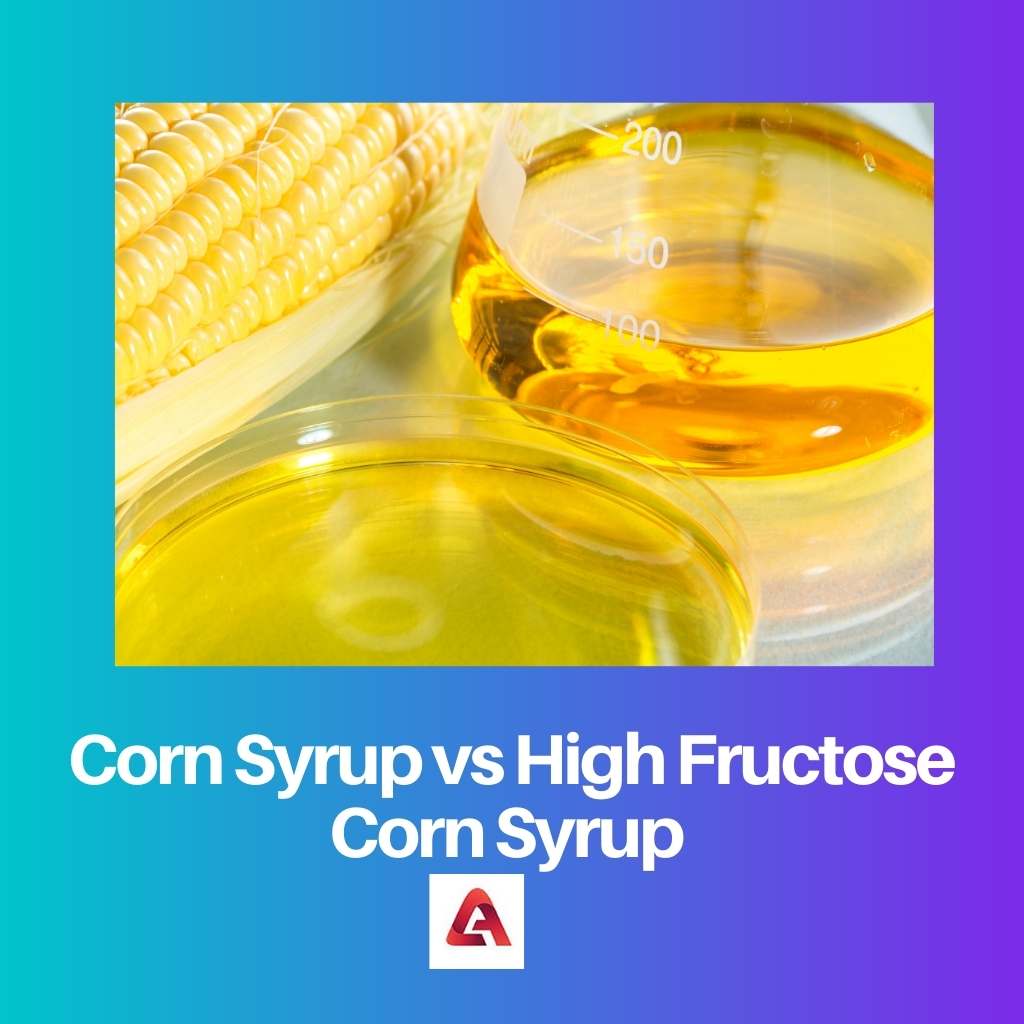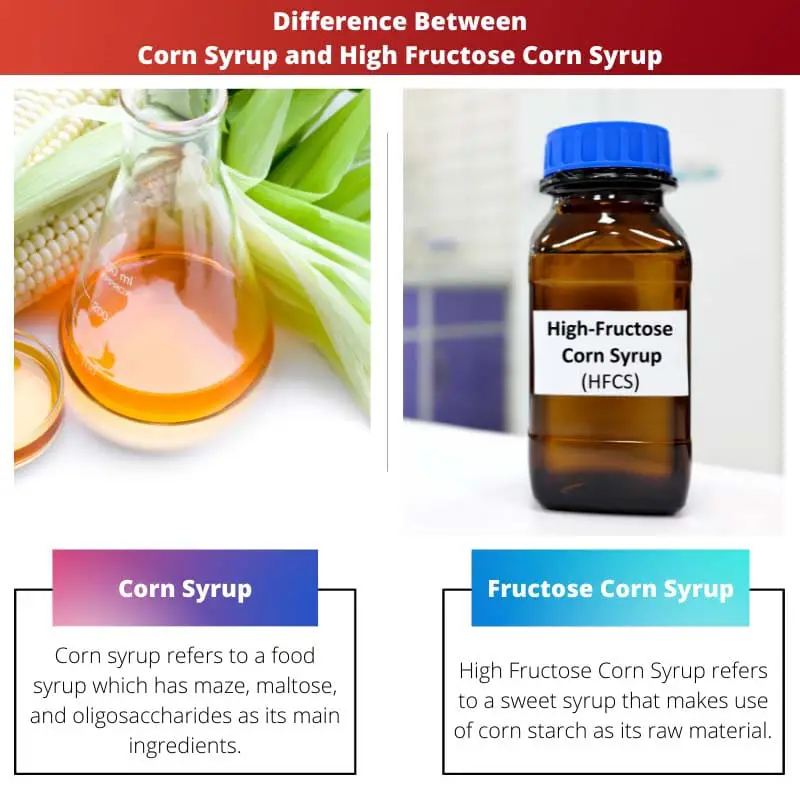Sweeteners are an indispensable part of most sweet food items. They have a practical application in processed foods. Corn Syrup and High Fructose Corn Syrup are two types of sweeteners made out of cornstarch.
While the two may seem similar, they have considerable differences in their properties and uses.
Key Takeaways
- Corn syrup contains 100% glucose, whereas high fructose corn syrup (HFCS) undergoes enzymatic processing to convert some glucose into fructose.
- HFCS is sweeter than corn syrup due to its higher fructose content, enabling food manufacturers to use less for the same level of sweetness.
- The body metabolizes corn syrup and HFCS differently, potentially contributing to obesity, diabetes, and other health issues.
Corn Syrup vs High Fructose Corn Syrup
The difference between corn syrup and high fructose corn syrup is that corn syrup’s composition only consists of glucose. On the other hand, high fructose corn syrup consists of some amount of glucose as fructose. Moreover, corn syrup is not as sweet as high fructose corn syrup.

Corn syrup refers to a syrup that has corn starch as raw material. It is a constituent of almost all pancake syrups as a substitute for the rather expensive maple syrup.
In addition, the dextrose equivalent rating help evaluates different grades of corn syrup. Another name for corn syrup is glucose syrup. It has multiple uses and advantages.
High Fructose Corn Syrup is a safe ingredient for food and beverage manufacturing. It is also known as glucose-fructose, glucose-fructose syrup, and isoglucose. HFCs are easier to manufacture and handle.
Moreover, it is considerably cheaper than sucrose. Wheat, potatoes, and rice serve as sources of cornstarch for High Fructose Corn Syrup.
Comparison Table
| Parameters of Comparison | Corn Syrup | High Fructose Corn Syrup |
|---|---|---|
| Definition | Corn syrup is a food syrup with maze, maltose, and oligosaccharides as its main ingredients. | High Fructose Corn Syrup refers to a sweet syrup that makes use of corn starch as its raw material. |
| Sweetness | Corn syrup is less sweet than high fructose corn syrup. | High fructose corn syrup is proportionately way too sweeter than corn syrup. |
| Glucose content | Corn syrup consists entirely of glucose. | High fructose corn syrup consists of some glucose as fructose. |
| Use | Corn syrup is found in almost all pancake syrups as a substitute for the rather expensive maple syrup. | High Fructose Corn Syrup is used in jams, jellies, baked goods, and many other food products. |
| Another Name | Another name for corn syrup is glucose syrup. | Another name for High Fructose Corn Syrup is isoglucose. |
What is Corn Syrup?
Corn syrup refers to a food syrup that has a maze, maltose, and oligosaccharides as its main ingredients. These constituents’ proportions vary from one variety of corn syrup to the other.
Another name for corn syrup is glucose syrup. It has a practical application in foods to add volume, stexture, enhance flavor, and prevent the crystallization of sugar.
Corn syrup has several uses. It is a vital part of commercially prepared food items as a sweetener, thickener, and humectant. Corn syrup is a component of almost all pancake syrups as a substitute for the rather expensive maple syrup.
Corn syrup is readily available for consumption as light corn syrup and dark corn syrup in the market. Light corn syrup has a clear and moderately sweet taste.
On the other hand, dark corn syrup is a warm brown color. Dark corn syrup consists of molasses, which enhances its flavor.
The hydrolysis reaction’s extent determines corn syrup’s sweetness and viscosity. Dextrose equivalent rating help evaluate different grades of corn syrup.

What is High Fructose Corn Syrup?
High Fructose Corn Syrup is a sweet syrup that uses corn starch as a raw material—another name for High Fructose Corn Syrup is isoglucose. HFCs is a safe raw materials for the manufacture of food and beverages.
In China, HFC makes up 20% of the sweetener demand. Another name for HFC in Japan is isomerized sugar. HFC is a component of adulterated honey.
HFC consists of 76% carbohydrates and 24% water. It doesn’t contain any fats, proteins, or micronutrients.
High Fructose Corn Syrup is a part of jams, jellies, baked goods, and many other food products. It has a practical application in the manufacture of soft drinks.
Moreover, it is considerably cheaper than sucrose. Wheat, potatoes, and rice serve as sources of corn starch for High Fructose Corn Syrup.
High Fructose Corn Syrup is cost-effective and offers an ideal sugar level. It consists of 24% water, fructose, and glucose. High Fructose Corn Syrup is a constituent in breakfast cereals and processed food items.
To conclude, High Fructose Corn Syrup has varying characteristics and uses.
Main Differences Between Corn Syrup and High Fructose Corn Syrup
- Corn syrup is a food syrup with a maze, maltose, and oligosaccharides as its main ingredients. In contrast, High Fructose Corn Syrup refers to a syrup that uses corn starch as raw material.
- Corn syrup is less sweet than high fructose corn syrup. On the other hand, High fructose corn syrup is sweeter than corn syrup.
- Corn syrup comprises entirely of glucose. In contrast, High fructose corn syrup consists of some glucose in the form of fructose.
- Corn syrup is a component of almost all pancake syrups as a substitute for the rather expensive maple syrup. On the other hand, High Fructose Corn Syrup is used in jams, jellies, baked goods, and many other food products.
- Another name for corn syrup is glucose syrup. In contrast, other High Fructose Corn Syrup names are glucose-fructose and isoglucose.




